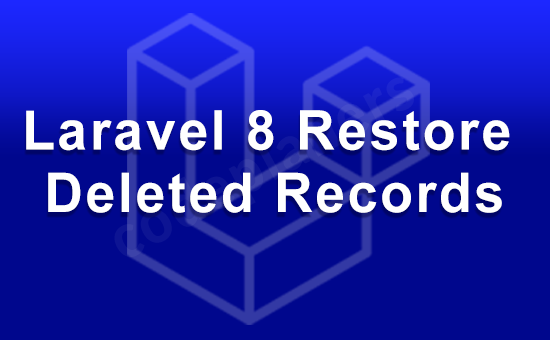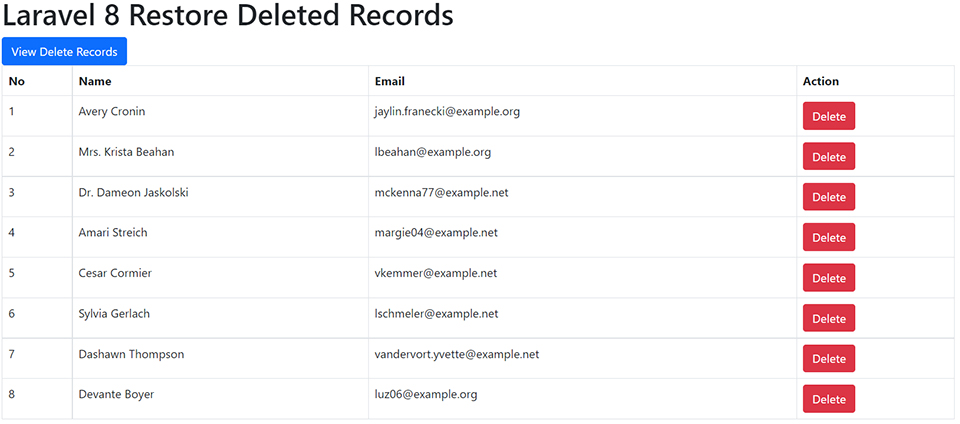
Hi Dev,
Today, i we will show you laravel 8 restore deleted records. This article will give you simple example of laravel 8 restore deleted records. you will learn laravel 8 restore deleted records. So let’s follow few step to create example of laravel 8 restore deleted records.


Step 1: Install Laravel
composer create-project --prefer-dist laravel/laravel blog
Step 2: Add SoftDelete in User Model
php artisan make:migration add_sorft_delete_column
database/migrations/add_sorft_delete_column.php
<?php
use Illuminate\Database\Migrations\Migration;
use Illuminate\Database\Schema\Blueprint;
use Illuminate\Support\Facades\Schema;
class AddSorftDeleteColumn extends Migration
{
/**
* Run the migrations.
*
* @return void
*/
public function up()
{
Schema::table('users', function(Blueprint $table){
$table->softDeletes();
});
}
/**
* Reverse the migrations.
*
* @return void
*/
public function down()
{
Schema::table('users', function (Blueprint $table) {
$table->dropSoftDeletes();
});
}
}
run migration:
php artisan migrate
app/Models/User.php
<?php
namespace App\Models;
use Illuminate\Contracts\Auth\MustVerifyEmail;
use Illuminate\Database\Eloquent\Factories\HasFactory;
use Illuminate\Foundation\Auth\User as Authenticatable;
use Illuminate\Notifications\Notifiable;
use Illuminate\Database\Eloquent\SoftDeletes;
class User extends Authenticatable
{
use HasFactory, Notifiable, SoftDeletes;
/**
* The attributes that are mass assignable.
*
* @var array
*/
protected $fillable = [
'name', 'email', 'password'
];
/**
* The attributes that should be hidden for arrays.
*
* @var array
*/
protected $hidden = [
'password', 'remember_token',
];
/**
* The attributes that should be cast to native types.
*
* @var array
*/
protected $casts = [
'email_verified_at' => 'datetime',
];
}
Step 3: Add Dummy Users
php artisan tinker \App\Models\User::factory(10)->create();
Step 4: Create Route
need to create some routes for add to cart function.
routes/web.php
<?php
use Illuminate\Support\Facades\Route;
use App\Http\Controllers\UserController;
/*
|--------------------------------------------------------------------------
| Web Routes
|--------------------------------------------------------------------------
|
| Here is where you can register web routes for your application. These
| routes are loaded by the RouteServiceProvider within a group which
| contains the "web" middleware group. Now create something great!
|
*/
Route::get('users', [UserController::class, 'index'])->name('users.index');
Route::delete('users/{id}', [UserController::class, 'delete'])->name('users.delete');
Route::get('users/restore/one/{id}', [UserController::class, 'restore'])->name('users.restore');
Step 5: Create Controller
app/Http/Controllers/UserController.php
<?php
namespace App\Http\Controllers;
use Illuminate\Http\Request;
use App\Models\User;
class UserController extends Controller
{
/**
* Display a listing of the resource.
*
* @return \Illuminate\Http\Response
*/
public function index(Request $request)
{
$users = User::select("*");
if ($request->has('view_deleted')) {
$users = $users->onlyTrashed();
}
$users = $users->paginate(8);
return view('users', compact('users'));
}
/**
* Write code on Method
*
* @return response()
*/
public function delete($id)
{
User::find($id)->delete();
return back();
}
/**
* Write code on Method
*
* @return response()
*/
public function restore($id)
{
User::withTrashed()->find($id)->restore();
return back();
}
/**
* Write code on Method
*
* @return response()
*/
public function restoreAll()
{
User::onlyTrashed()->restore();
return back();
}
}
Step 6: Create Blade Files
need to create blade files for users
resources/views/users.blade.php
<!DOCTYPE html>
<html>
<head>
<title>Laravel 8 Restore Deleted Records</title>
<meta name="csrf-token" content="{{ csrf_token() }}">
<link href="https://cdn.jsdelivr.net/npm/bootstrap@5.0.2/dist/css/bootstrap.min.css" rel="stylesheet">
<script src="//ajax.googleapis.com/ajax/libs/jquery/1.11.3/jquery.min.js"></script>
</head>
<body>
<div class="container">
<h1>Laravel 8 Restore Deleted Records</h1>
@if(request()->has('view_deleted'))
<a href="{{ route('users.index') }}" class="btn btn-info">View All Users</a>
<a href="{{ route('users.restore.all') }}" class="btn btn-success">Restore All</a>
@else
<a href="{{ route('users.index', ['view_deleted' => 'DeletedRecords']) }}" class="btn btn-primary">View Delete Records</a>
@endif
<table class="table table-bordered data-table">
<thead>
<tr>
<th>No</th>
<th>Name</th>
<th>Email</th>
<th>Action</th>
</tr>
</thead>
<tbody>
@foreach($users as $user)
<tr>
<td>{{ $user->id }}</td>
<td>{{ $user->name }}</td>
<td>{{ $user->email }}</td>
<td>
@if(request()->has('view_deleted'))
<a href="{{ route('users.restore', $user->id) }}" class="btn btn-success">Restore</a>
@else
<form method="POST" action="{{ route('users.delete', $user->id) }}">
@csrf
<input name="_method" type="hidden" value="DELETE">
<button type="submit" class="btn btn-xs btn-danger btn-flat show_confirm" data-toggle="tooltip" title='Delete'>Delete</button>
</form>
@endif
</td>
</tr>
@endforeach
</tbody>
</table>
</div>
</body>
<script type="text/javascript">
$('.show_confirm').click(function(e) {
if(!confirm('Are you sure you want to delete this?')) {
e.preventDefault();
}
});
</script>
</html>
Now we are ready to run our example
php artisan serve